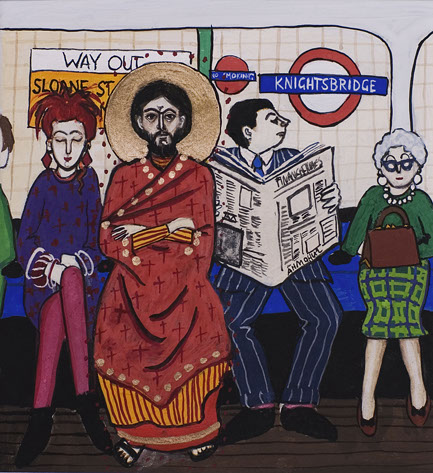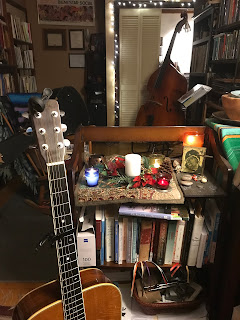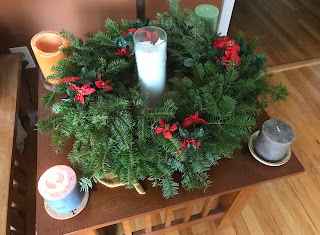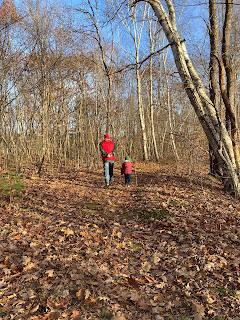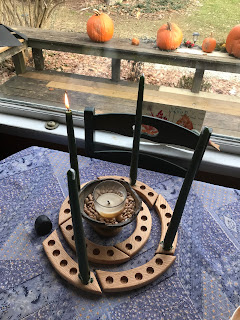Later we feasted on a modified Italian tradition with a three fish supper cooked by our brilliant and talented son-in-law. It was a quiet and rich time of being with one another in love. Here are my homily notes...
Grace and peace to you dear L’Arche Ottawa as we celebrate this second Christmas Eve of the Covid era: it has been a trying, heart-breaking, demanding, clarifying, confusing, oddly restful year that at times has challenged our mental, physical, and spiritual health. It has made clear that we’ve been called by God to live as a community crafted on compassion. Fr. Richard Rohr tells us that: “Com-passion asks us to go where it hurts, to enter into the places of pain, to share in brokenness, fear, confusion, and anguish. Compassion challenges us to cry out with those in misery, to mourn with those who are lonely, to weep with those in tears. It requires us to be weak with the weak, vulnerable with the vulnerable, and powerless with the powerless. Compassion means full immersion in the condition of being human...
… and immersion into the human condition is what we’ve done. We’ve known profound loss as Michelle and then Louise crossed over from life into death and life beyond death by God’s love. We’ve encountered changes in our community life and leadership as well as a new way of being together given lockdowns, Zoom, masks, vaccinations, and social distancing. Considering all that has happened, I want to say out loud to you what the angels told the shepherds on Christmas Eve: “Do not be afraid! Good news and joy are coming, and this will be a sign for you: you will find a child wrapped in bands of cloth and lying in a manger.” The baby Jesus – a vulnerable child – was a sign of God’s presence during life’s ups and downs. That is, baby Jesus wasn’t a mistake – unexpected, to be sure, surprising, you bet – but not a mistake.
It’s easy to forget that often God shows up in the world in what is small, unexpected, and vulnerable. That’s why powerful, professional, and busy people so often miss meeting Jesus – especially baby Jesus born into a stable – they’re too busy and distracted to be still – and know. But not you, L’Arche Ottawa, not you. At your best, you practice going slowly so that you can see and love the Christ Child in each and all of us. In this, you are like the shepherds, a living witnesses to the soul of Christmas Eve. You may not realize it going through your daily tasks, but you quietly show the world something of that precious Christ Child whenever you love one another in community. Your patience, laughter, trust, tears, tenderness, and remarkable forgiveness for one another reveals the baby Jesus among us for those with eyes to see.
You do this quietly – humbly– much like the Lord’s birth in a stable in that dink, backwater town called Bethlehem. Carefully, not perfectly but always honestly, you give shape to what God’s love looks like in the flesh. St. Luke writes that Jesus was born in the darkness – not the bright lights downtown where anybody might notice – but in a barnyard cave filled with work animals. In the middle of nowhere – surrounded by people who were discarded or forgotten by their society – love came down from heaven at Christmas. Sound familiar?
It could be L’Oasis. Or Le Tournesol, Mountainview, Wabanna, La Caravanne or La Source. I keep a picture of Terry, Sylvan, Jim, and Raymond and a few assistants dressed as shepherds on my prayer wall at home to keep me grounded. I have another with Francine, Lorie, Louise, and Michelle dressed as angels – and one of Chastity adorned as the Blessed Virgin Mary. No one is rushed or harried in these pictures. No one is forgotten, dismissed, discarded, or overlooked either. Each and all are treasured with a unique and cherished place in community. Honestly. Humanly. Not sentimentally but humbly and profoundly – and I call it holy ground.
Today we celebrate that Jesus is with us now: in community, our hearts, our homes, our supper tables. I think I’ve even seen Jesus at some of our Friday Zoom meetings, too. He’s been with us quietly this year as we found new ways to love, respect, and care for one another during lockdowns and loss.
But let’s be clear that part of Christmas is trusting that Jesus will be with us NEXT year, too – and we’re going to need him! There’ll be some heavy lifting in comm-unity where we’ll have to trust living by faith not sight. I give thanks that Christ is with us now (by whatever name we give him) and pray we’ll continue to discover him in the most unexpected places as the New Year ripens. I’m grateful to God that L’Arche Ottawa makes Jesus visible to a broken world with quiet humility and grace. And I am blessed to share a small part of it with you. Thank you, dear friends: Merry, Christmas et Joyeaux Noel.
